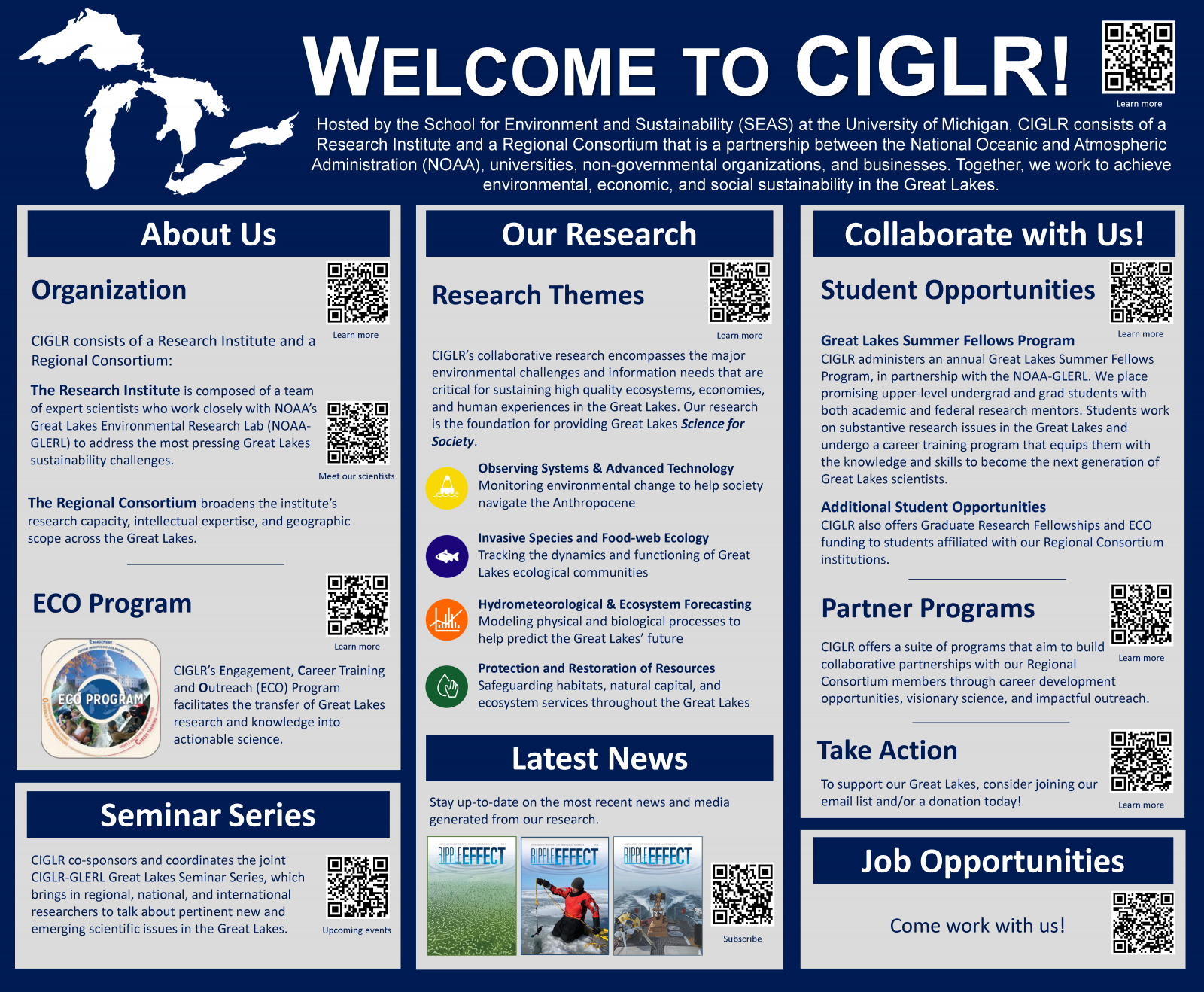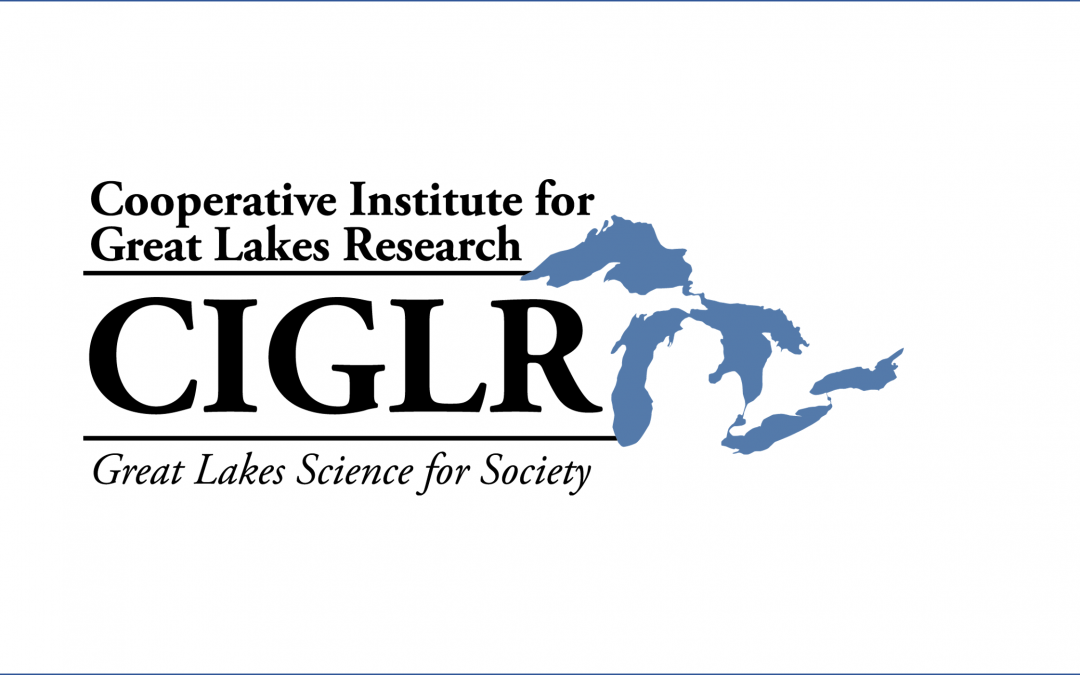Welcome Readers!
We’re excited to share CIGLR Connect’s first post with everyone. CIGLR Connect is an informal, casual, blog-style publication that will connect our readers and science by sharing news from CIGLR’s Research Institute and Consortium, program updates, staff and student highlights, collaborations, and more. Our first post will introduce our cooperative institute, CIGLR, and answer some frequently asked questions about who we are. We can’t wait for you to get to know us better!
.
Who is the Cooperative Institute for Great Lakes Research (CIGLR)?

Our “Welcome to CIGLR” poster shares information about our organization, our research, ways to collaborate, and more! Click on the image for a larger view. [pdf poster view]
The CIGLR Research Institute complements NOAA’s workforce with a highly-skilled, permanent group of research scientists, postdoctoral fellows, technicians, staff, and administration that expands NOAA’s research expertise and is fully-integrated into NOAA’s scientific enterprise. All CIGLR Research Institute personnel hold appointments at the University of Michigan and are collocated with our NOAA GLERL sponsor.
-
- CIGLR Research Scientists serve as principal investigators on CIGLR Cooperative Agreement (NOAA) and external proposals, engage in collaborative research with NOAA scientists and Regional Consortium partners, and mentor undergraduates, graduate students, and postdoctoral fellows.
- CIGLR postdoctoral fellows work with CIGLR and GLERL Research Scientists to receive early career training in NOAA mission-related research topics in the Great Lakes.
- CIGLR research support staff work with CIGLR and GLERL principal investigators on technical aspects of their research projects.
The Regional Consortium broadens our research capacity, intellectual expertise, and geographic scope across the Great Lakes. Consortium partners include ten universities and five private sector organizations that collaborate with CIGLR and NOAA GLERL to conduct research, transition research to operations, and engage with stakeholders. Our Consortium partners include:

The CIGLR Regional Consortium map shows the locations and names of our partners around the Great Lakes region. Click on the image for a larger view. [pdf map view]
-
- Central Michigan University
- Cornell University
- Grand Valley State University
- Lake Superior State University
- University of Michigan
- Michigan State University
- University of Minnesota-Duluth
- Ohio State University
- University of Windsor
- University of Wisconsin-Milwaukee
- Fondriest Environmental
- Great Lakes Environmental Center
- LimnoTech
- The Nature Conservancy, Great Lakes
- National Wildlife Federation, Great Lakes Regional Center
Our cooperative institute was established in 1989, with a Memorandum of Understanding (MOU) between the University of Michigan and the Undersecretary of Oceans and Atmosphere in the United States Department of Commerce. CIGLR began in the College of Engineering at the University of Michigan, but was moved to the School for Environment and Sustainability (SEAS) formerly the School of Natural Resources and Environment (SNRE) in 2002. Together, we work to achieve environmental, economic, and social sustainability in the Great Lakes.
.
What is a NOAA cooperative institute?
NOAA Cooperative Institutes are non-federal academic and non-profit research institutions supported by the National Oceanic and Atmospheric Association (NOAA) that demonstrate the highest level of performance and conduct research that supports NOAA’s mission and strategic plan. Cooperative Institutes host strong, long-term research collaborations between NOAA and its partners and have different research themes, ranging from atmospheric research to oceanic exploration. Cooperative Institutes are located at institutions whose geographic expanse extends from Hawaii to Maine and Washington to Florida. Currently, NOAA supports 16 Cooperative Institutes consisting of 80 universities, and research institutions across 33 states, the District of Columbia, US Territories, and Canada.
.
Why we changed our name:
In 2017, our cooperative institute went though a name change from CILER to CIGLR. The name CIGLR reflects the increasing breadth of research that we facilitate in the Great Lakes, which has evolved from our original focus on natural science (limnology and ecosystem ecology) to interdisciplinary work that includes social science, engineering, and design. While CIGLR builds on the foundations laid by CILER, the new institute differs from its predecessor in several ways: greater investment by the host, more impactful partnerships, more interdisciplinary research, greater focus on co-design and quicker transitions from research to application.
.
Who is NOAA GLERL?
CIGLR’s primary NOAA research partner is the Great Lakes Environmental Research Laboratory (NOAA GLERL) within the NOAA Office of Oceanic and Atmospheric Research (OAR). Our researchers are housed at NOAA GLERL in Ann Arbor, Michigan and work in direct collaboration with NOAA GLERL scientists. Scientists from CIGLR and NOAA GLERL partner to study the most pressing issues in the Great Lakes, including climate change, harmful algal blooms, and protection of ecosystem services.
.
Are there other places to follow CIGLR and check-in on what we are up to?
Yes! We are located on:
How to contribute to CIGLR Connect?
We would like to open up the CIGLR Connect blog space to anyone from the CIGLR Research Institute, Regional Consortium, program award recipients, and affiliated students. Please email CIGLR Communications Specialist Aubrey Lashaway ([email protected]) with questions and to learn more.

